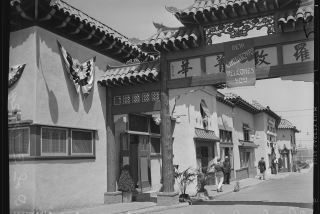Longing for an Egg Cream? Don’t Ask!
- Share via
The authentic egg cream is nearly extinct in New York City. And down the drain with the bubbling seltzer, milk and chocolate syrup have gone ethnic neighborhoods, restaurants and theaters, Bonwit Teller and Alexander’s, affordable jazz clubs, the Latin Quarter and the Copacabana and scores of rare and small booksellers.
When a die-hard New Yorker said his reason for living in this difficult city was to get an egg cream any time he wanted, it was understood as a reference to all that made New York City magnificent. The Big Apple has always had more of everything. Now what it has a lot more of is what makes one city just like another: all-too recognizable chain stores and franchises in a city that once gloried in its uniqueness.
Although it does not appear on the menu there any more, Veselka’s on Second Avenue is one of the last places to get a decent egg cream 24 hours a day. It is where Yiddish theater once flourished and where there is now a multiplex theater, the Gap and some undistinguished New York University real estate. On 14th Street, the Palladium, the German restaurant Luchow’s and the Spanish import store Casa Moneo have vanished. So have S. Klein’s and Mays department stores, where working moms could buy affordable school clothes for their kids and uptown debutantes found imported knitwear and exquisite accessories. Staples, the Virgin Megastore and Barnes & Noble have moved in.
Further uptown, in Yorkville, Hungarians sit in Starbucks lamenting the closing of coffeehouses and Paprikas Weiss, the last of the once-plentiful Hungarian food and specialty shops. It’s another landmark gone in an area where Eastern Europeans felt at home, and younger, assimilated generations could get a taste of Old World charm and atmosphere. The short list of the delicacies they’ll miss having easy access to: peppers with sweet-and-sour cabbage stuffing; white peppers and round peppers; sweet, rose and hot paprika; goose liver; plum and sour cherry lekvar jam; goulash and lecsos dinners. “This is the saddest thing,” a retired cook says, uncreasing his Magyar Nemzet newspaper. “The ethnic people built up the neighborhood. Immigrant people, like myself.”
Across town on West 66th Street, the St. Nicholas boxing arena was where successive waves of immigrant groups found boxing a metaphor for the struggle of daily existence and the triumph of a few hard-won victories. The street address for the arena no longer exists, but one block up is an exorbitantly priced, sissified Reebok Club. The arena’s closing, and that of Madison Square Garden’s boxing department in 1988, marked the end of New York as the capital of boxing. New York once had innumerable fight clubs. Today, with the exception of an occasional high-profile event, it has become a boxing ghost town.
There’s no need to be afraid of walking around Times Square, now a safe and sanitized mixture of Disney World and a piece of the Las Vegas strip. It is where tourists can come to see any number of revivals from a time when the New York musical theater was glorious. “The popular culture of New York City was America’s cultural ideal,” says theater historian Herbert G. Goldman. “America’s hit songs came from Broadway shows, which made New York unique and important.”
New York City still has one of the greatest concentration of cultural institutions in the world. However, music and art weren’t always stuck indoors. They were part of daily life, and if you didn’t like what you heard on the streets, parks and subways, you could get your fill of salsa, blues, Middle Eastern music or jazz late into the night for affordable prices. Now, after one pricey set at the Upper West Side jazz club Birdland, music lovers have to cough up another cover fee or head home.
Change is inevitable, and it seems graceless and retrograde to bemoan the passing of institutions. Still, something fragile and wonderful is being lost in the homogenization of American cities. New York once held claim to a charm born of its refusal to be like other cities; it insisted on its neighborhood singularity, and the places that made this city distinct catered to immigrants and the assimilated alike. Now, with every new chain store and franchise, New York City becomes more familiar to the out-of-towners and more remote to its own wondering and nostalgic citizens.
More to Read
Sign up for Essential California
The most important California stories and recommendations in your inbox every morning.
You may occasionally receive promotional content from the Los Angeles Times.










